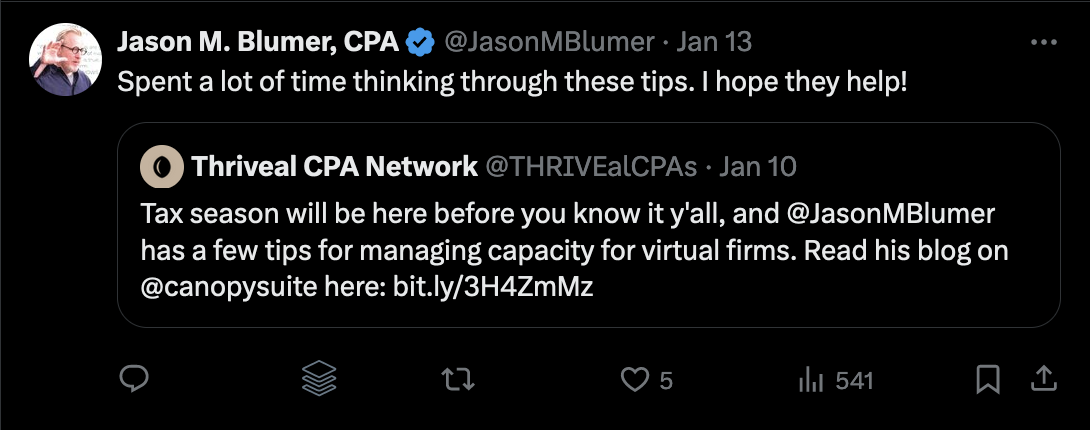
Whether you run an accounting firm, agency, or consultancy, your clients don’t just hire you for your expertise. They want dependability, trust, and personalized guidance—those traits lead to long-lasting working relationships, which means good news for your business’s retention, revenue, and reputation.
To drive client engagement as a professional services business, you need tools and technology to support customers in every stage of your relationship. Short links and QR Codes ease communication, streamline workflows, and give your customers simple and easy ways to connect with your team. Plus, they give you meaningful data and analytics to understand clients and improve your services.
Read on to learn how you can use these tools during these four stages of the customer journey to drive engagement and keep clients coming back for more.
1. Make the most of your marketing
Client engagement actually starts before someone signs a contract to work with your firm—during the marketing and sales process. A first impression can make all the difference, so try these tactics to offer a more convenient experience to every potential customer.
Create connected touchpoints
Whether your potential clients first encounter you through your marketing materials, a member of your team, or a happy current customer, technology gives them a quick, easy way to learn more:
- A QR Code on a billboard or direct mail advertisement lets them scan to visit your website, while real-time analytics shows you how many scans are happening in real time.
- Short links are a great way to drive referrals. Provide your customers with a personalized referral link to your “contact us” form—when they refer someone who becomes a new customer, reward them with a discount or gift.
- During live events, share a QR Code at the end of a presentation to learn more about your firm, or offer a short link at your booth for attendees to reach out to your team after the event.
Best of all, you can add QR Codes or short links to your existing materials quickly and easily. These tactics let you lead with convenience and connection, removing friction for potential customers and making it easy for them to say yes to your services.
Show your work
Short links and QR Codes are the perfect interactive channel to show prospects what you can do, especially for creative agencies or firms with vivid examples of their work. For example, Northrop Grumman is an aeronautics company that contracts with clients all over the world. In 2021, they used QR Codes on print and social ads to drive engagement with their “Portals to Space” microsite and augmented reality (AR) activation. The campaign drove awareness of their work to consumers and potential clients during the 36th Space Symposium event.

Use QR Codes in-person and digitally that people can scan to review unique, memorable examples of your services. Accounting firms might link to a video showing their team’s personality and achievements, and social media studios can share engaging, high-performing campaigns that instantly appeal to potential customers. These touchpoints instill confidence, excitement, and trust in customers before they’ve even hired you.
Qualify leads
Technology can also help you qualify potential customers. Provide a short link to your website or a QR Code on channels like a billboard or direct mail campaign that links to a lead qualification form or quiz, and ask for details about your prospects’ budget, goals, and company size.
The results let your team confirm that potential customers are a good fit before a discovery call and help you prepare for an initial meeting. Plus, a lead qualification form can reassure potential customers that they’re in the right place and build confidence in your firm from the first interaction.
2. Engage clients while onboarding
Once someone becomes a customer, you can start on the right foot through an engaging onboarding and kickoff process. This is when you’ll show customers the quality of services they can expect from your team and set the tone to reassure and support them.
Build trust (and remove friction) during onboarding
The hallmark of an engaged client experience is removing friction from customer interactions. On an episode of the Unbillable Hours podcast, Florian Heinrichs shared an example of how this can look. One professional services firm noticed that their onboarding survey wasn’t working—clients would respond, but they wouldn’t complete every question or provide in-depth details.
They realized that new clients didn’t have the depth of relationship or trust to share sensitive, detailed information through a form before a kickoff call. Instead, they moved to recording and sending the link to a personalized video for each new client before the kickoff—the video shared an agenda, put a face to a name, and invited client questions. This approach built greater trust and drove a more successful kickoff experience.
That’s a perfect example of how technology is an essential tool for meeting customers’ needs and removing friction. Try recording a short video or creating customized project materials before onboarding, and share them using a short link sent via text or email. Review analytics to make sure customers have accessed materials, and make data-driven changes to your process as needed.
Learn about clients’ company culture and needs
PeopleMetrics conducted a Most Engaged Customers Study to better understand client experiences with accounting firms, and the top driver of engagement was “extra effort.” One way that respondents defined this quality was when firm employees understood their unique culture as a client: what they do and their processes. That knowledge equips the firm to deliver top-notch service under any conditions.
Establish rapport early in the relationship (before or after onboarding) by conducting an interview or sending clients a survey via short link. Use this research to understand their company culture, their team’s working norms and communication preferences. You can also ask for help updating those details once or twice per year, resending the short link to confirm any team changes or evolving project needs so your team stays in the loop.
3. Enhance your project workflows
As you complete projects and deliver results for your clients, you can drive efficiency and streamline processes by using tech like short links and QR Codes at each step.
Share measurements and results
What’s the best way to predict how long a client will stay with you? On an episode of the Professional Services Pursuit podcast, Greg Daines, CEO of ChurnRX, shares that measurable results are the best predictor of retention—customers who achieve them stay six times longer. Greg continues: “If you get zero results, but you still measure [and share] them, it still doubles customer lifespan.”
Clearly, measuring and presenting your results to professional services clients are two of the most important activities for engaging and keeping your customers. Create a transparent, open line of communication with your clients by regularly sharing the results your firm delivers:
- Marketing agencies can share the engagement and traffic they’ve driven
- Accountancies can show how much money or time they saved for clients
- IT firms can point to any data leaks or attacks they prevented
During monthly or quarterly check-in calls, provide charts and metrics that show what your team has accomplished and the difference it makes for the client. Share a QR Code that customers can scan to visit slides for themselves to zoom in, review results more closely, or revisit them later.
Beyond those calls, send your clients more regular dashboards and updates on a weekly or monthly basis—text or email a short link so they regularly can see the updated numbers for themselves.
Facilitate payments
If your firm is delivering above-and-beyond service and clear, measurable results, your clients are getting more than their money’s worth—so make sure that the payment process doesn’t pull focus from your client experience or add stress to their workload.
When a new invoice is available, share a unique, personalized short link via text so clients can instantly review and approve their next payment in seconds. You can also email invoices and include a QR Code that takes them to a payment portal or lets them quickly submit payment from their mobile device.
For in-person meetings, a QR Code at your front desk can also take them to sign into their account, review invoices, and pay right away—or, better yet, let them “set and forget” recurring payments for retainers that auto-renew each month or quarter.
4. Deepen and maintain relationships
Outside of the high-quality work your firm delivers for clients, your customers look to your team to provide a deep level of care and commitment. You can build trust and connection with your customers by showing up for them above and beyond the projects they contract you to complete—and technology can help.
Request customer feedback
Help your clients feel heard by inviting ongoing feedback, both positive and negative. Create regular touchpoints by sending a short link by text or email and inviting them to fill out a satisfaction survey, share a video describing their experience working with you, or even make a referral.
When a customer interaction goes poorly, let clients share their thoughts on what went wrong and what should’ve gone better. Send a feedback form or a short link to meet with your team after any less-than-positive incidents. You’ll show your team’s commitment to getting things right and rebuild goodwill with your clients in the process.
Recognize milestones
Show your clients you care by reaching out at key moments, from their anniversary working with your firm to team birthdays and holidays. You might even send them a card via direct mail—such personal gestures are less common today, so firms that take the time to send them stand out. Go the extra mile by printing a QR Code on your note that clients can scan to redeem a gift card or small gift.
Share ongoing knowledge
One of the best ways to support your customers and continue building trust with them is through sharing industry updates and best practices throughout your relationship. You can do that through your social media presence, by sharing helpful content via email, or through live or virtual events with your customers.
Take Jason Blumer—he’s the founder of Blumer CPAs and the Thriveal community for CPA firms. He’s built a platform and audience of 10,000 followers on X, sharing tips and insights to help other firms grow, and using short links to share his helpful content on social:

When you continually share helpful information with your audience to help them grow their knowledge, they see you as more than a firm providing a service: You’re a dependable expert and resource that’s helping them grow.
Stay in touch
Churn does happen—especially when a primary point of contact within a company moves on to another role. That transition doesn’t have to mean a loss of business, though; it can even mean growth.
Hopefully, your original client remains a customer, but either way, you can reach out to your connection during or after their transition and send them a short link to stay in touch. Provide a quick and easy form to collect details about their new role and contact information to start the conversation and see if you’re the right fit to support their new company.
Engage your clients to build your business
Customer relationships are the key to unlocking retention, building your reputation, and driving growth through referrals. Your firm doesn’t just provide a service—you ensure that your clients have the tools, insights, and support they need to operate and grow their own businesses.
Technology like QR Codes and short links help you make client communication and guidance more efficient, available, and data-driven. As a result, your team gains more time to focus on providing better service, thoughtful client interactions, and above-and-beyond support. Transform your firm by putting tech at the forefront.